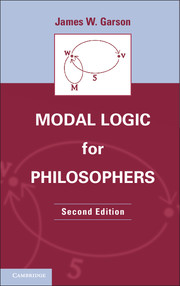Book contents
- Frontmatter
- Contents
- Preface to the Second Edition
- Preface
- Introduction: What Is Modal Logic?
- 1 The System K: A Foundation for Modal Logic
- 2 Extensions of K
- 3 Basic Concepts of Intensional Semantics
- 4 Trees for K
- 5 The Accessibility Relation
- 6 Trees for Extensions of K
- 7 Converting Trees to Proofs
- 8 Adequacy of Propositional Modal Logics
- 9 Completeness Using Canonical Models
- 10 Axioms and Their Corresponding Conditions on R
- 11 Relationships between the Modal Logics
- 12 Systems for Quantified Modal Logic
- 13 Semantics for Quantified Modal Logics
- 14 Trees for Quantified Modal Logic
- 15 The Adequacy of Quantified Modal Logics
- 16 Completeness of Quantified Modal Logics Using Trees
- 17 Completeness Using Canonical Models
- 18 Descriptions
- 19 Lambda Abstraction
- 20 Conditionals
- Answers to Selected Exercises
- Bibliography of Works Cited
- Index
18 - Descriptions
Published online by Cambridge University Press: 05 June 2014
- Frontmatter
- Contents
- Preface to the Second Edition
- Preface
- Introduction: What Is Modal Logic?
- 1 The System K: A Foundation for Modal Logic
- 2 Extensions of K
- 3 Basic Concepts of Intensional Semantics
- 4 Trees for K
- 5 The Accessibility Relation
- 6 Trees for Extensions of K
- 7 Converting Trees to Proofs
- 8 Adequacy of Propositional Modal Logics
- 9 Completeness Using Canonical Models
- 10 Axioms and Their Corresponding Conditions on R
- 11 Relationships between the Modal Logics
- 12 Systems for Quantified Modal Logic
- 13 Semantics for Quantified Modal Logics
- 14 Trees for Quantified Modal Logic
- 15 The Adequacy of Quantified Modal Logics
- 16 Completeness of Quantified Modal Logics Using Trees
- 17 Completeness Using Canonical Models
- 18 Descriptions
- 19 Lambda Abstraction
- 20 Conditionals
- Answers to Selected Exercises
- Bibliography of Works Cited
- Index
Summary
Russell’s Theory of Descriptions
English phrases that begin with ‘the’, such as ‘the man’ and ‘the present king of France’, are called definite descriptions (or descriptions, for short). So far, we have no adequate logical notation for descriptions. It is possible to translate ‘the man is bald’ by choosing a constant c for ‘the man’, a predicate letter P for ‘is bald’, and writing: Pc. However, treating the description as if it were a constant will cause us to classify some valid arguments as invalid.
For example, it should be clear that (1) entails (2).
(1) Aristotle is the philosopher who taught Alexander the Great.
(2) Aristotle taught Alexander the Great.
If we choose the constants: a for Aristotle, and g for Alexander the Great, we might notate (2) as (2′).
(2′) Tag
If we treat ‘the philosopher who taught Alexander the Great’ as a constant g, then (1) is notated by (1′).
(1′) a≈g
However, there is no logical relationship between the atomic sentences (1′) and (2′) that would cause us to recognize that the argument from (1′) to (2′) is valid. Clearly we need a way to notate the internal structure of ‘the philosopher who taught Alexander the Great’ if we are ever to show that (1) entails (2) in logic.
- Type
- Chapter
- Information
- Modal Logic for Philosophers , pp. 383 - 406Publisher: Cambridge University PressPrint publication year: 2013



